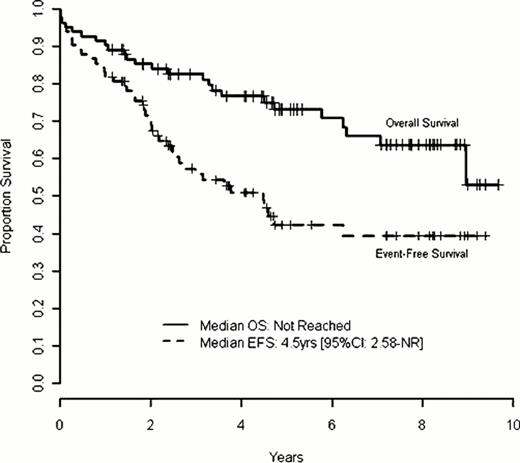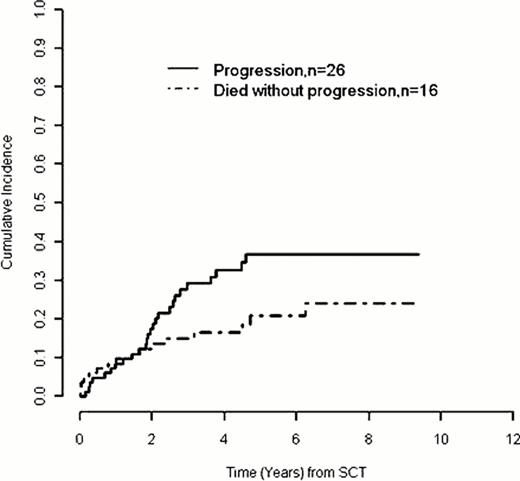Abstract
AL is a plasma cell dyscrasia characterized by the pathologic production of monoclonal light chains which misfold, deposit in various organs, including the heart, and can cause early death. High dose melphalan with stem cell transplant (SCT) results in high hematologic response rates and is a standard treatment for eligible patients. Achieving a complete hematologic response (CR) to SCT results in extended event-free and overall survival (OS), up to 8 and 13 years respectively in one large series. (Blood 2011; 118:4346) We have studied the addition of novel agents as consolidation following risk-adapted SCT (RA-SCT) in order to improve hematologic response (HR) rates and therefore outcomes. (Br J Haem 2007;139:224; Amyloid 2010;17:80a) In this report we examine the long-term outcomes of patients who received initial therapy with RA-SCT followed by consolidation for hematologic response less than CR (HR < CR).
We performed a retrospective study to assess the HR rates, incidence of hematologic progression and overall survival (OS) of AL patients enrolled at diagnosis on two consecutive phase II trials using RA-SCT with consolidation for HR < CR (NCT01527032 and NCT00458822). OS was calculated from date of transplant to date of death or last follow up. Median event free survival (EFS) and OS were estimated by the method of Kaplan Meier. Cumulative incidence function was used to estimate the incidence of progression and death.
Between 2002 and 2011, 83 patients were enrolled and underwent RA-SCT on these trials and, following RA-SCT, those with HR < CR received consolidation with thalidomide and dexamethasone (TD) in the first and bortezomib and dexamethasone (BD) in the second trial. Thirty-six patients had cardiac involvement (43%) and all patients had free light chain measurements employed to score hematologic response and progression using consensus criteria (Am J Hematol 2005;79:319; Blood 2010;116:1364a). The frequency of CR following SCT was 24% and increased to 48% with post-SCT consolidation. The CR rates increased at 1 year compared to 3 months post-SCT from 21% to 36% with TD and from 28% to 62% with BD. With a median follow up of 5.1 years, the EFS is 4.5 years (95% CI: 2.6 to not reached) and the OS of all patients has not been reached (Figure 1). Sixteen patients died prior to hematologic progression and 26 patients have progressed with a cumulative incidence of hematologic progression of 8%, 18%, and 29% at 1, 2 and 3 years, respectively (Figure 2). Thirty-one percent (8/26) of relapsed patients have not required second-line therapy while among those who have, 78% (14/18) have responded including 44% (8/18) with CR. The median OS following hematologic progression was 5 years (95% CI: 2.6–5.8).
Half of the AL patients on initial therapy trials employing RA-SCT and consolidation for HR < CR achieved CR with 36% of pts on the TD and 62% on the BD consolidation trial in CR at 1 year post-SCT respectively. At 3 years post-SCT the cumulative incidence of relapse was 29% and a third of relapsed patients did not require therapy, likely due to the very sensitive serum free light chain assay that detects low level hematologic progression in the absence of organ progression. Almost 80% of patients requiring second-line therapy responded, over half with CR, and median OS after relapse was 5 years. These results indicate that initial therapy with RA-SCT and consolidation is an effective initial treatment strategy for patients with AL in the era of novel agents. With over 5 years of follow up the median OS has not been reached.
Comenzo:Millennium Pharmaceuticals, Inc.: Consultancy, Membership on an entity's Board of Directors or advisory committees, Research Funding. Off Label Use: Use of the investigational agent MLN9708, an oral proteasome inhibitor, in the treatment of relapsed or refractory light-chain amyloidosis. Hassoun:Millenium: Membership on an entity's Board of Directors or advisory committees, Research Funding; Celgene: Research Funding. Giralt:Celgene: Membership on an entity's Board of Directors or advisory committees, Research Funding; Millenium: Membership on an entity's Board of Directors or advisory committees; Onyx: Membership on an entity's Board of Directors or advisory committees, Research Funding. Landau:Millenium: Membership on an entity's Board of Directors or advisory committees, Research Funding; Onyx: Research Funding.

This icon denotes a clinically relevant abstract
Author notes
Asterisk with author names denotes non-ASH members.



This feature is available to Subscribers Only
Sign In or Create an Account Close Modal